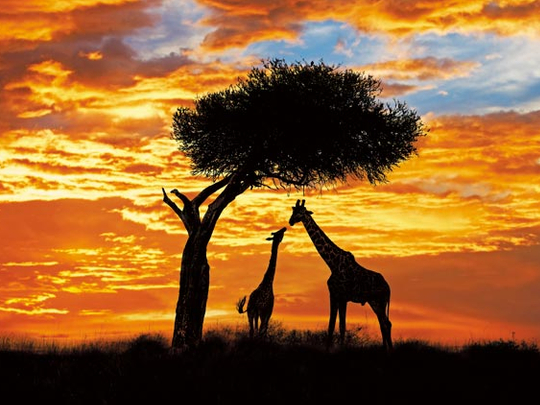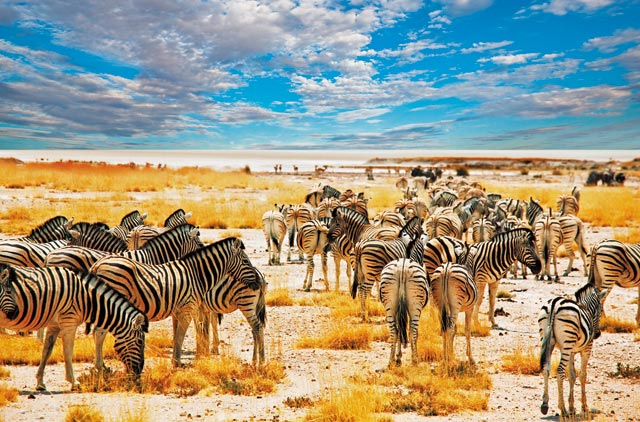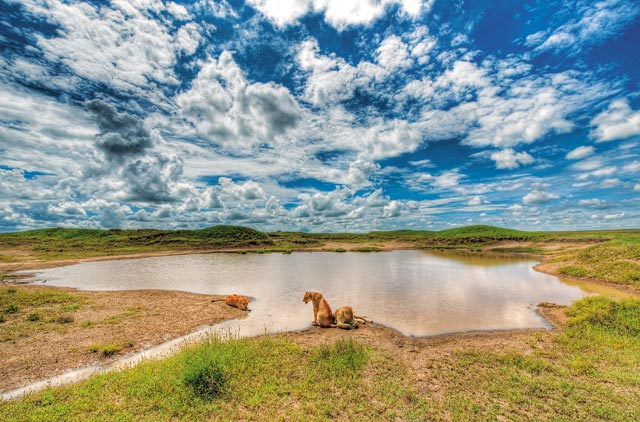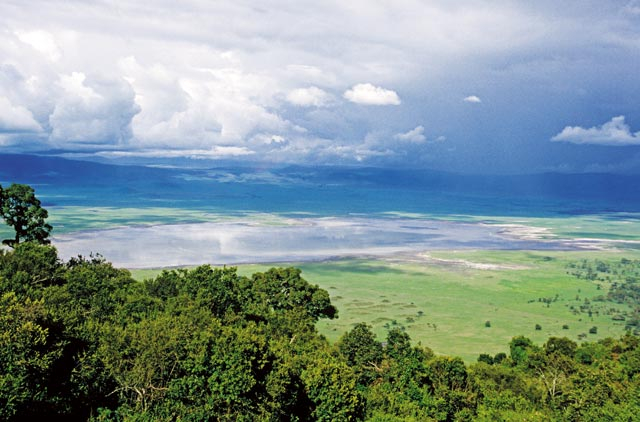
As the plane took off from Dar El Salaam, Tanzania’s largest city, we hit a bank of particularly glorious clouds. Luminous puffs of light and shadow scudded beneath us, vapour sparked into the hills and valleys of a nimbus metropolis stretching as far as the eye could see. In the distance, the black summit of Mount Kilimanjaro tore through the cotton canopy, its snow-capped top glittering in a hard diamond blaze, the Tolkienesque ruler of this kingdom of clouds.
It makes no difference to the poetry of the experience, but I was disappointed to learn that it wasn’t actually Africa’s highest mountain starring in our vista but Mount Meru, the continent’s ninth-highest mountain at 4,565 metres, located 70 kilometres west of Mount Kilimanjaro. It was an understandable mistake – we were, after all, flying into Kilimanjaro airport on the inaugural Qatar Airways flight from Doha. In honour of the event we were greeted with a ‘water salute’ as we touched down – two fire engines spurting an arc of water over the plane – and with the pulsing beats of a traditional Tanzanian tribal dance.
Duly welcomed, we moved on to the road and trundled into the dusty roads of Arusha, an agricultural town near Kilimanjaro airport, that for most tourists is a stop-off point en route to the major safari spots or to climb Tanzania’s great mountains.
It was my first taste of Africa and I was awed by the swathes of brightly clothed people lining the roads, packages balanced in gravity-defying towers on their heads, or sat at ramshackle stalls in the market area, selling everything from fruits and vegetables to plastic toys and second-hand shoes.
The town’s highlights are the clock tower, which is popularly believed to be situated at the midpoint between two termini of the old British Empire, Cairo and Cape Town, and the Tanzanite Experience, a museum and gem shop hosting a hive of information on Tanzania’s native violet-blue precious jewel, said to be more than 1,000 times rarer than diamonds.
In search of the Big Five
But the reason most visitors come to this country is, of course, the safari. Meaning ‘long journey’ in Swahili, this was certainly an apt description for what was to follow, as we set out at the crack of dawn the next morning in search of Africa’s majestic wild animals and, specifically, the Big Five – leopard, rhino, elephant, lion and buffalo – so-called because of their historic reputation as the most dangerous and difficult animals to hunt on foot.
After a heart-stopping flight on a bobbing 12-seater plane to the Serengeti, we scrambled out on to the little airstrip and entered the sturdy safari jeep that was to be our home, viewing platform and refuge from the many fierce and wild beasts that we were to become acquainted with over the next few days.
It is said that the Serengeti is one of the best places on earth for spotting animals, with more than 2,500 lions, 400 elusive cheetahs, and unknown numbers of hoofed creatures wandering the plains. This proved true almost immediately – the jeep had barely driven 20 metres before screeching to a halt for a languorous giraffe, casually chomping on leaves as he loped across the road, followed by a herd of Thompson gazelles leaping, scatty and panicked, into the undergrowth.
Most of you will have visited a zoo and had the opportunity to see beautiful and rare animals not only up close but in a reliable arena, somewhere you can be sure to see them without the need for a treacherous drive over bumpy, unmade roads. But, as any safari aficionado will no doubt tell you, that is nothing like the arresting, awe-inspiring exhilaration of seeing these creatures up close, for yourself, in the wild. It is nature’s soap opera and watching it unfold is an experience of real-life drama like no other.
From the tantalising anticipation of spying a cheetah about to pounce on a gazelle, to the infectious joy of watching lion cubs scrapping in the sand and plopping playfully on to their mother’s back, the theatre of the wilderness in all its cruelty, amorality and wonder cannot be beat.
Serengeti means ‘endless plain’ in Masai, and our drive through this flat, desolate area felt as if we were voyaging through the manifestation of meditation – boundless space, vast skies, a stark emptiness of pale grass unfolding into an eternal horizon. Located in the north of the country bordering Kenya’s Masai Mara and the Ngorongoro Conservation Area, it is the largest national park in Tanzania at 15,000 square kilometres, a huge protected area of grasses, savannah, clay plains and mountains in which wildlife can continue its age-old cycle of life and death, undisturbed.
Visits can be timed to coincide with incredible animal migrations. The most dramatic takes place in February, when the park’s 1.8 million wildebeest begin the 500-mile journey from the Ngorongoro area to the Masai Mara, while between October and December, around two million animals travel from the Serengeti hills in the north towards the southern plains in search of rain. In April, they return and in July to September they cross the Mara River. The creatures are constantly in flux, organic cogs turning in the circle of life as they seek out the purest water and freshest grass.
Luxury amid the wilderness
Our night in the Serengeti was spent at the Four Seasons Safari Lodge, a network of luxury suites and villas tottering on wooden platforms, woven seamlessly into the natural surroundings. I felt strangely exposed in my room, the fourth wall of which was all glass, presenting an uninterrupted panorama of the watering hole where zebra, elephant, baboon and giraffe all quietly gather to drink at dusk.
There’s no lack of creature comforts for humans either, as this five-star lodge provides gourmet dining, spa facilities, evening entertainment and a sense of total luxury amidst the safari wilderness. Dusty and bedraggled after a full day’s drive, a warm bath, cool drink and the restful silhouettes of wild animals against a brilliant African sunset was the perfect way to unwind.
Another early rise the next day took us to Nogorongoro crater, a Unesco world heritage site formed from volcanic activity 25 million years ago, creating a seamless circular mountain chain called a caldera – technically a collapsed volcano – within which lies a lake and rich grassland. The descent into the crater provides spectacular, uninterrupted views of the 20-kilometre landscape, in which the whole circumference of the great circle of life is played out before your very eyes. I had the Elton John song on repeat in my head as views I’d imagined were artistic license on behalf of Disney unfurled in front of us – ambling herds of zebra, giraffe, wildebeest, elephant, antelope, ostrich, and cattle tended by Masai tribesmen, all drifting together in a dream-like menagerie.
Derived from the Swahili word for ‘Soda Lake’, our summertime visit saw Lake Magadi shrunk into a dark central pool, its outer rim dried into a brilliant white salt crust, while flocks of flamingoes and other waterfowl waded in the centre. With such a high concentration of animals in a relatively small space, Ngorongoro is one of the best game-viewing areas in the world, and we were lucky enough to spot all of the Big Five, including the very rare Black Rhino, within its perimeter.
But the highlight had to be the nail-biting sight of a leopard perched precariously in a tree, in flight from a pack of lions who were patiently staking her out on the ground – while the kings of the jungle do not prey on leopards, they will kill them as rival predators.
After the excitement of the day, the cool lawns and still verandah of The Manor hotel in Ngorongoro offered a welcome chance to relax. With ten luxurious cottages and 20 suites, the magnificent main Manor House is set within a 1,500-acre coffee estate and its rich, dark wood furniture, grand hallways and Cape Dutch-style architecture is evocative of a romanticised and long departed colonial past. Tanzania’s tourism industry is blossoming, and much work has been put into ensuring that visitors receive the friendliest of East African welcomes
The Cradle of Mankind
Tanzania also boasts one of the most significant human marvels of the world, Oldupai Gorge, a steep-sided ravine about 48km long in the eastern Serengeti, and one of the most important paleoanthropological sites in the world. Also known as the Cradle of Mankind, the gorge is no Grand Canyon, but the rock strata spanning back millions of years are easy to make out.
Instrumental in furthering the understanding of early human evolution, this site was occupied by man’s earliest ancestor almost two million years ago and serves as direct evidence of humankind’s beginnings in Africa. The museum, founded in 1970 by Mary Leakey is a modest affair, but it all comes to life with a little narration from the guides who are trained archaeologists.
The Laetoli Room has the cast of the famous hominin footprints preserved in volcanic ash and unearthed by Mary Leakey’s team in 1978, providing convincing evidence of bipedalism. It sends a shiver down your spine to imagine the two people walking over this very land, 3.6 million years ago.
The museum also houses artefacts from the great safari, the human migration that began in Africa and resulted in mankind’s colonisation of the globe. The museum’s staff, all trained anthropologists and archaeologists are on site to explain how the excavations are done and experts still come out and dig every summer, helped by the Masai.
Whether animal lover, nature lover, history lover or merely a lover of luxury, there’s something in Tanzania for everybody.
Admittedly, millions of years ago, mankind did not have the luxury lodges and five star service of the modern tourist to persuade them to stay, but after a sojourn in the glorious setting of East Africa you may wonder why our ancient ancestors ever came to leave Tanzania’s spectacular wild lands.









